Warlords of Europe (Conquest Gaming/Kyle Battle, Ken Griffin and Russ Rupe, 2010)
2-4 players / 12 + / 2-4 hours
"Okay, dad, say good-bye to your castle in Germany! My army is rolling in!"
What You Get:
"Okay, dad, say good-bye to your castle in Germany! My army is rolling in!"
"Ha, you don't frighten me Danish pig-dogs!"
"Yeah, right. I play 'Greek Fire' first to kill off four of your guys."
"Go and boil your bottom, son of a silly person, you and all your silly knnnnnnnnnn-iguts!"
"Whatever. Then I play 'Heroic Leadership' to give me ten-sided dice."
"I blow my nose at you, empty-headed animal food-trough wiper!"
"Um, okay, yeah, then I play 'Seige' which reduces your rolls to the ten-sided, also."
"Ah, I don't want to talk to you no more! Now go away or I shall taunt you a second time!"
"Too late, dad..."
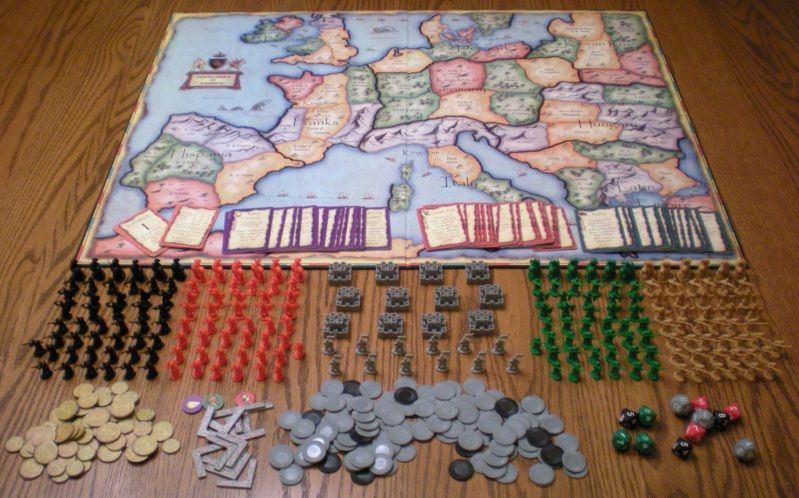 |
| Lots to play with. |
What every kid wants: toys! Even (or maybe especially) "kids at heart" will drool over the components in this box, namely the 200+ detailed, plastic army and castle pieces. I'm not afraid to admit it! The castles are basic and stout, while the spearmen, swordsmen, archers, knights, and warlords are all finely rendered. One minor issue is that the warlords are all grey instead of each player owning a few in their own color. As they are captured, you really need to remember which belonged to whom since there are ways to get them back. There are three decks of cards, under-sized and sturdy, that provide some big bonuses and great thematic flavor. The cardboard coins and tokens are thick enough to handle and endure. There is a baggie of mini-poker chips which can be stacked under some units to represent greater numbers. The board is solid, stylistically antique-ish, and not too "busy." There are some small issues in distinguishing a few borders, here and there, and you will experience a good deal of territory over-crowding - unfortunately an attribute endemic to most dudes-on-a-map games not produce by Eagle. Then throwing caution to the wind, the designers toss out the commonplace six-sided die and instead include a gaggle of d8s, d10s, and d12s. There's nothing particularly special about these dice in themselves, but just for the refreshing change in replacing the overused standards!
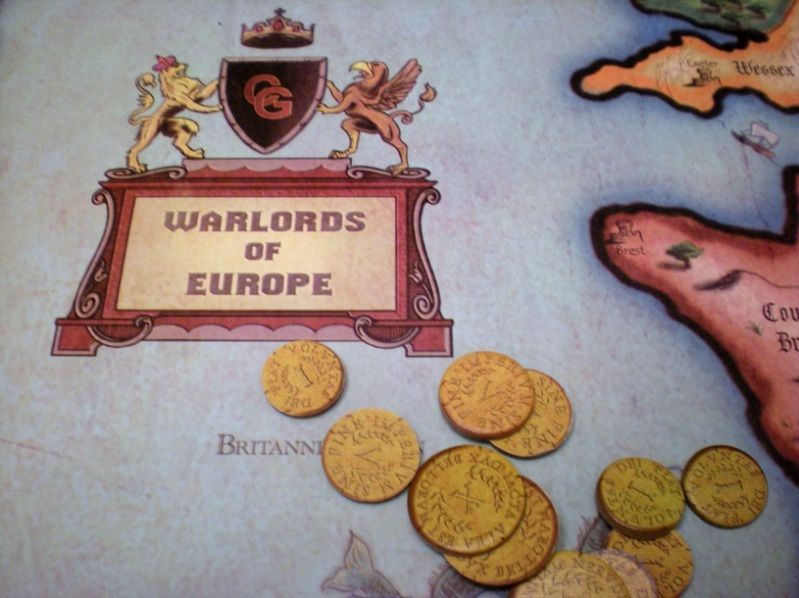 Warlords of Europe takes mechanics that all conquest wargamers are familiar with from other titles, and mixes in a few tweaks for a unique experience. Its closest cousin is probably Ikusa (aka Samurai Swords of the 1980s MB GameMaster Series). As a medieval lord, all players begin with a couple of fiefs, a castle, and a small army with the goal of expanding territory and capturing a majority of Europe's castles. More lands and castles yield more money - with extra bonuses in consolidating all the fiefs within larger kingdoms. That money is used mostly to build up your army or hire mercenaries (which are the same units, but you only get to keep them for one turn). The units available include archers (who fire separately in combat as ranged units) and then spearmen, swordsmen, and formidable knights. Warlords are also available in limited supply that, in addition to their combat value, act as generals who can move any number of units attached to them up to two territories. Combat is determined by cross-referencing several tables based on combined arms, morale, initiative, terrain, weather, and leadership. No, not really - you just throw some dice. But the refreshing aspect here is the three types of dice. Which ones you roll is not based upon the units involved, but rather the terrain. Normally, both sides will resort to the d8. However, if you are defending in the forest or in a partially built castle, you get d10s; if you're holed up in the mountains or in a completed castle, you can break out the intimidating d12s. Better units require lower numbers to score hits. There is yet another crucial component that really defines this game: cards. Each card in the three different decks provides some pretty significant bonuses that can really make or break your strategy. Conquest cards are earned once per round as long as you've conquered at least one fief. All players receive a Papal card every turn as long as they're in good standing with the Pope (which is almost always). Finally, merchant cards are available for purchase. You will acquire a good number of these over the course of the game and their effective use cannot be stressed and appreciated enough.
Warlords of Europe takes mechanics that all conquest wargamers are familiar with from other titles, and mixes in a few tweaks for a unique experience. Its closest cousin is probably Ikusa (aka Samurai Swords of the 1980s MB GameMaster Series). As a medieval lord, all players begin with a couple of fiefs, a castle, and a small army with the goal of expanding territory and capturing a majority of Europe's castles. More lands and castles yield more money - with extra bonuses in consolidating all the fiefs within larger kingdoms. That money is used mostly to build up your army or hire mercenaries (which are the same units, but you only get to keep them for one turn). The units available include archers (who fire separately in combat as ranged units) and then spearmen, swordsmen, and formidable knights. Warlords are also available in limited supply that, in addition to their combat value, act as generals who can move any number of units attached to them up to two territories. Combat is determined by cross-referencing several tables based on combined arms, morale, initiative, terrain, weather, and leadership. No, not really - you just throw some dice. But the refreshing aspect here is the three types of dice. Which ones you roll is not based upon the units involved, but rather the terrain. Normally, both sides will resort to the d8. However, if you are defending in the forest or in a partially built castle, you get d10s; if you're holed up in the mountains or in a completed castle, you can break out the intimidating d12s. Better units require lower numbers to score hits. There is yet another crucial component that really defines this game: cards. Each card in the three different decks provides some pretty significant bonuses that can really make or break your strategy. Conquest cards are earned once per round as long as you've conquered at least one fief. All players receive a Papal card every turn as long as they're in good standing with the Pope (which is almost always). Finally, merchant cards are available for purchase. You will acquire a good number of these over the course of the game and their effective use cannot be stressed and appreciated enough.T for Teens:
I may sound like a broken record before I finish up with our collection of this genre, but the same principle applies here: my kids (boys and girls) really have a deep interest in dudes-on-a-map, conquest games, yet struggle with strategic decision-making and also get quite restless while waiting on their next turn. But it goes back to the toys. The little figures seem to be a natural attraction for kids (my kiddo gamers are ages 9 and 10). I can remember playing similar games back in junior and senior high for the sheer, unquantifiable awesomeness of it all. And the publication and sales of such games proves there is a market among adults in the hobby. Maybe it's because we start young? I mean, even as we're playing, my 4-year old daughter will grab my extra army pieces and head off to the other end of the table to feed them, and dress them, and drop them off at daycare. Or, um, should that be knightcare...?
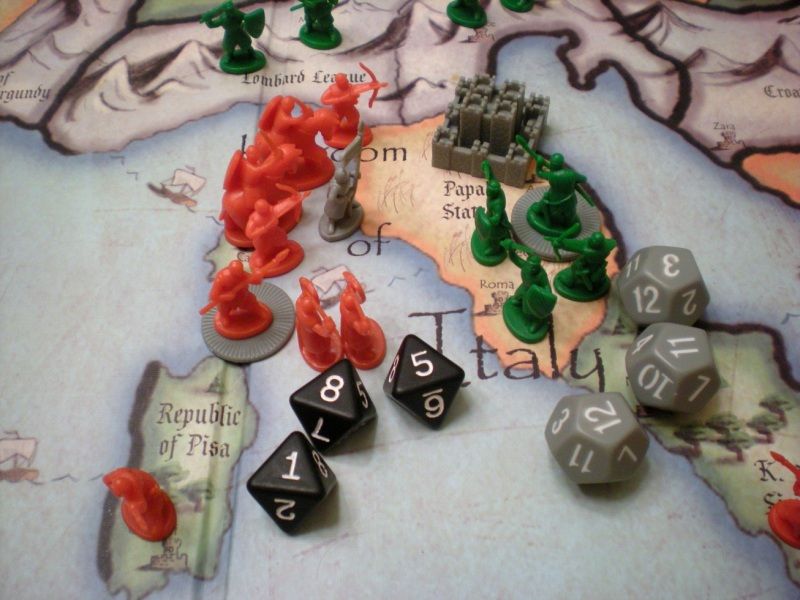 |
| More to see than just the d6! |
My kids really get into the Middle Ages setting. I suspect most other children will, too. They delight in battling with swords, storming castles, and sending forth their knighted hero to rescue the princess...only in this case, it's a warlord, which actually is kind of awkward. No matter. I share their enthusiasm for the theme. Playing the GameMaster series as teenagers, my friends and I dreamed that Milton Bradley would give us the opportunity to use our strategic wits, honed on the fields of ancient Rome and medieval Japan, in the fiefs of Western Christendom. Sadly that was never the case. But this oversight has now been gloriously corrected by Larry Davis' spiritual successors at Conquest Gaming, LLC.
Outside of wargamers, downtime and game length are probably the biggest turn-offs in this genre. Warlords has two mechanics that seem to address both problems, yet do not alleviate them completely. Though honestly, I'm not sure that's possible for a game of this nature without removing its heart and soul. It would be unfair to ask for evangelical titles to convert the light hobby or Euro gamer to the wargaming faith. So how does its mechanics connect with kids?
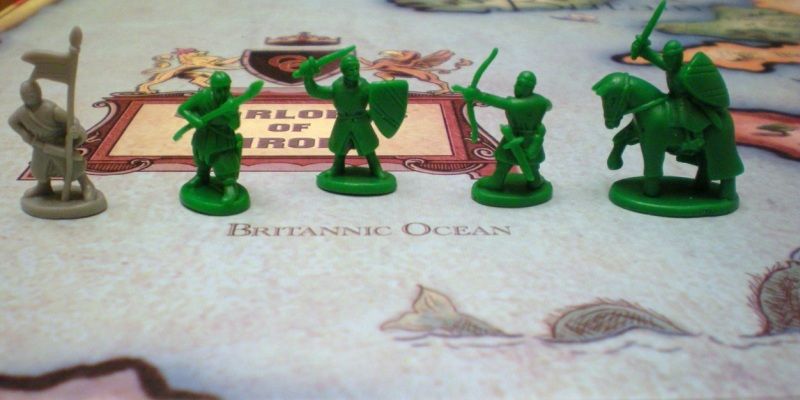 To alleviate downtime, a number of actions are executed simultaneously (or nearly so) during a Group Phase. These brief actions are resolved in fairly quick succession and include a victory check, taking a Papal card, levying taxes, mustering and deploying units, building castles, assigning initiative, and purchasing Merchant cards. These are settled in a particular order based on initiative, which changes each round, and anyone may play cards during these action phases when indicated on the card. It is a helpful mechanic to break up all of the logistics, shorten the focus on individual campaigning, and keep players involved in a more frequent rotation. Another added benefit to concurrent mustering and deployment is that all players have a chance to replaces losses before the next campaign season begins. When the campaigning does start, you will be waiting while the other players announce their movement, resolve battles (which could involve you), and finally maneuver reserves. There is downtime.
To alleviate downtime, a number of actions are executed simultaneously (or nearly so) during a Group Phase. These brief actions are resolved in fairly quick succession and include a victory check, taking a Papal card, levying taxes, mustering and deploying units, building castles, assigning initiative, and purchasing Merchant cards. These are settled in a particular order based on initiative, which changes each round, and anyone may play cards during these action phases when indicated on the card. It is a helpful mechanic to break up all of the logistics, shorten the focus on individual campaigning, and keep players involved in a more frequent rotation. Another added benefit to concurrent mustering and deployment is that all players have a chance to replaces losses before the next campaign season begins. When the campaigning does start, you will be waiting while the other players announce their movement, resolve battles (which could involve you), and finally maneuver reserves. There is downtime.While still an afternoon affair for 3-4 player games, the victory condition mechanic and scenario options go a long way to help reduce overall game length. Rather than conquering every last square inch of land or completely eliminating all enemies, your goal is to capture and hold a majority of castles (all of them in a 2-player game). That is still no easy task - which accounts for the games 2-4 hour span. Yet it provides a finite goal in what might otherwise turn into an exhaustive marathon of give and take. This measurable victory condition will also guide players' strategy and is conducive to streamlined game play. Castles are extremely important in this game, which makes sense given their political, military, economic, and social dominance of the times. You must own one in any given kingdom in order to collect taxes from its fiefs. If you control a majority, or all, of the fiefs in a kingdom, you are awarded bonuses in the form of extra taxes and free levees. Losing your last castle means you no longer collect money, nor can you hire knights - and that's a tough slog. On another note, suggested scenarios scale the playable map area to a smaller number of kingdoms, eliminating the slow and boring build-up and forcing players into early confrontation.
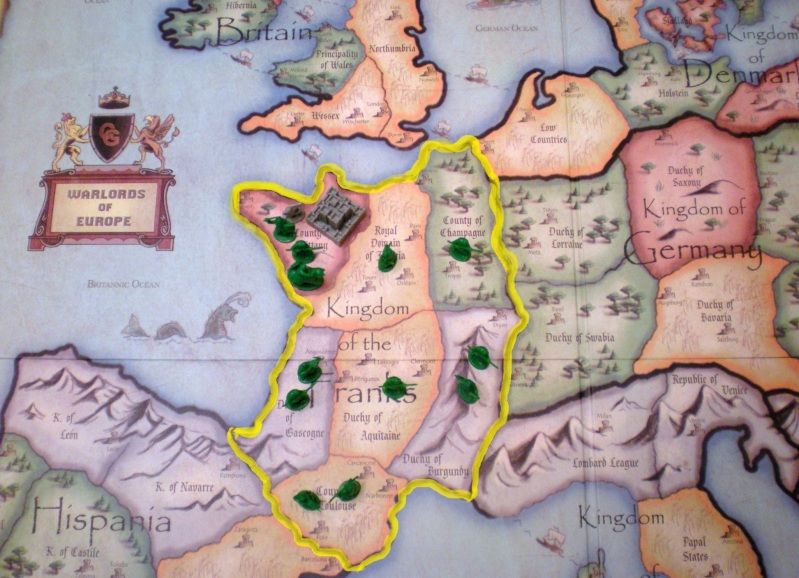 |
| Six to seven fiefs comprise one kingdom (highlighted in yellow). Own them all and reap the rewards. |
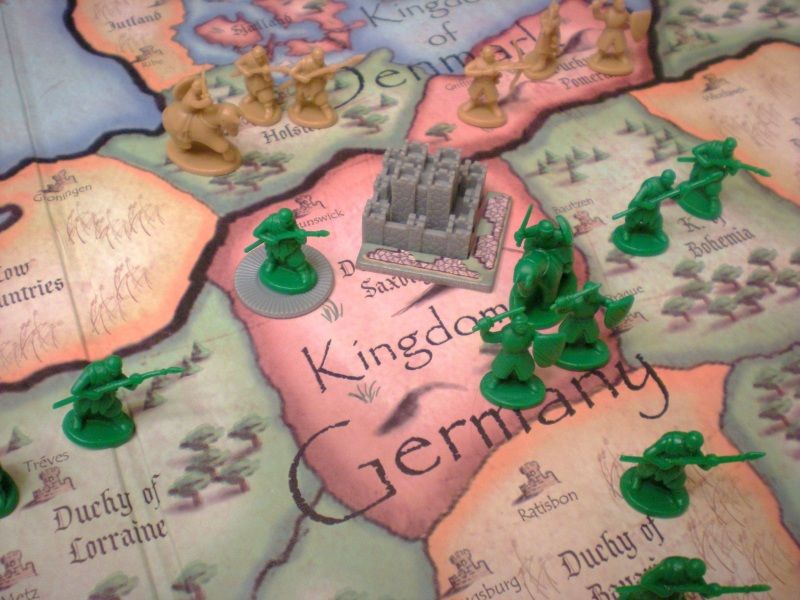 |
| An unfinished castle. |
There is one quirky aspect that can significantly affect game play. On your first turn, your only goal is to successfully consolidate the 6-7 fiefs of your starting kingdom. From your 2 start territories, you'll invade the other lands and fight the peasants there: 1 in mountain fiefs, 2 in forest fiefs, and 3 in plains and farming fiefs. Now most of the kingdoms are fairly balanced and the success rate for accomplishing this task is very high. However, while it won't occur every game, it will eventually happen that a player will fail to consolidate his kingdom and, therefore, miss out on the early bonus gold and spearmen. It may sound minor, but that person will then be disadvantaged right from the start and must be especially diligent to reach equal footing.
Okay I'll Shut-Up Now:
In the end, I personally give Warlords of Europe an 8 on the Board Game Geek scale (Very good game. I like to play. Probably I'll suggest it and will never turn down a game). It would not be the first wargame I recommend introducing to your children, especially younger than junior high. But kids, like adults, will be hard pressed to resist its sweeping historical narrative and epic theme. While most mechanics will be familiar to even moderate wargamers, top-notch components and fresh tweaks create a fun medieval experience. Simply stated, if enjoy conquest games you must have this title.
 |
| Card examples (from top): Conquest, Papal, Merchant |
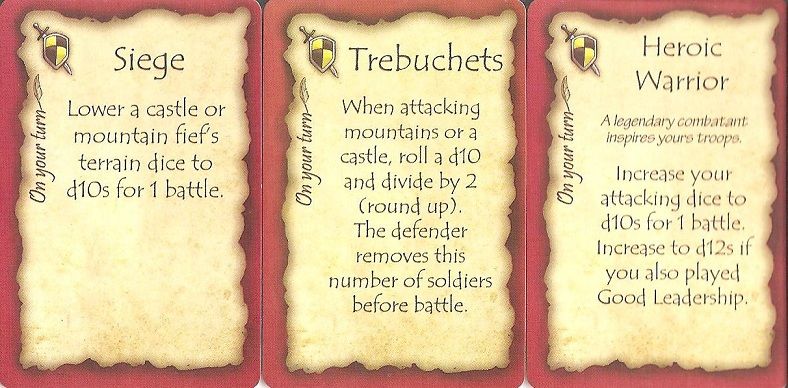
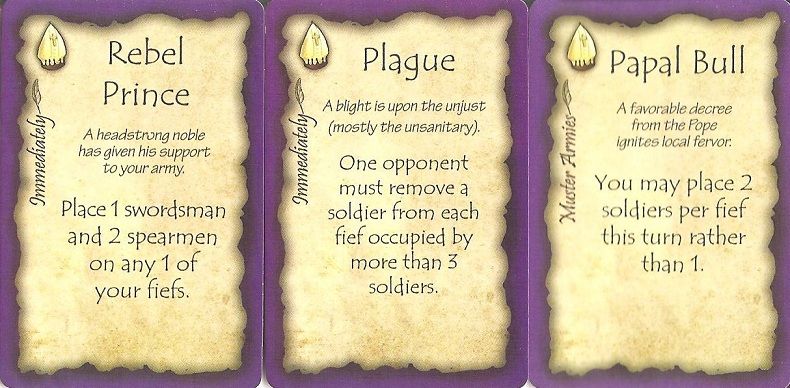
No comments:
Post a Comment